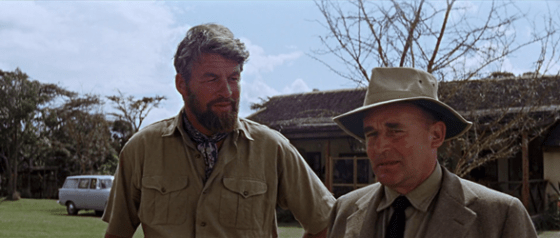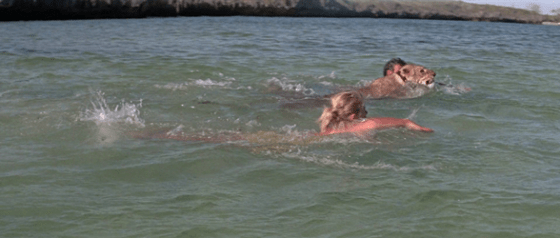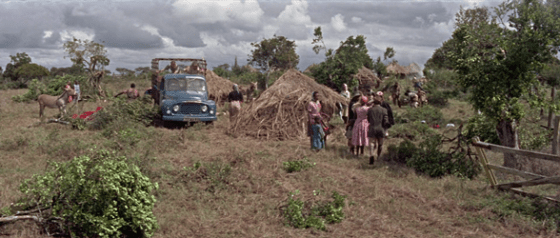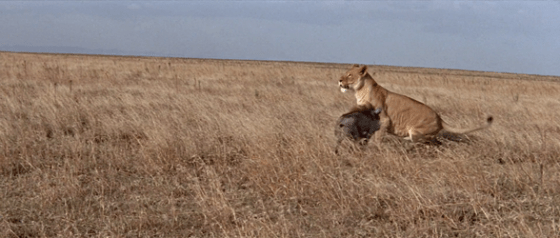Some of you may know about my six-year old daughter, the Little One (the ‘LO’), whom I’ve written about occasionally, in the context of our travels.
This time, the LO stars in one of my film reviews. Because Born Free happens to be the first film which fits my blog’s timeline and which the LO watched along with me. We’ve watched other films in theatres, and (over the course of the lockdown) at home, but all of them have been animated films or Harry Potter. But this last Saturday, reliving our trip to Kenya at the beginning of this year, I was reminded of Joy Adamson (whose paintings we saw at the Nairobi National Museum), and I decided we should watch Born Free.
I had already told the LO a basic gist of what happened: that Joy Adamson adopted three lion cubs after they were orphaned, and how one of those cubs was named Elsa (“Elsa?! As in Elsa, from Frozen?”—Frozen, so far, has been the LO’s favourite film, and Elsa, the heroine-queen of Frozen, is her favourite character bar none). We settled down to watch, and I, knowing the LO’s propensity to chat, settled down to watch her reaction to the film.
George Adamson (Bill Travers) is game warden in the Northern Frontier District of Kenya, where he lives with his wife Joy (Virginia McKenna, who was married to Bill Travers in real life too). One day, George receives news of a man-eating lion that’s been terrorizing the villages nearby. (There’s a preliminary scene of a lion attacking a woman washing clothes by the river, and the LO is all goggle-eyed when the lion appears on the scene: “Is that Elsa? Is that the lioness? Will there be blood?”)
George Adamson tracks down the lion and shoots it, but right after, the lion’s mate comes charging out from a nearby cave. George kills her too, and then discovers the reason for her charging him: she has three cubs.
George brings the cubs back home to Joy (who already has a rock hyrax named Patty, and is obviously very much at home with wildlife). Joy is immediately smitten with the cubs (so is the LO. There is much gushing). The cubs are not inclined to drink milk from a bottle and seem to be intent on starving themselves to death, but the Adamsons persevere. Finally, there’s a breakthrough, and then there’s no looking back.
The cubs grow by leaps and bounds, and Joy christens the tiniest one—her favourite—Elsa. The cubs are very playful and very naughty. (The LO is in splits of laughter at their antics. She approves of all this mischief, and pays no attention to our explanation that these cubs are very small, they don’t know what mayhem they’re causing, and so on. She’s decided these are role models).
One person who gets a taste of the cubs’ mischief is George’s boss, John Kendall (Jeffrey Keen), who comes visiting and is ‘treed’ on a sofa by a playful Elsa. John cannot see why the Adamsons are so charmed by their pet lion cubs, but he’s a good, sympathetic man, who understands the Adamsons. As the cubs grow larger and more unruly, John suggests they be sent to a zoo.
Joy is heartbroken, so much so that when George takes the three cubs to Nairobi Airport to send them off, Joy is miserable… until George returns, bringing Elsa back with him. He didn’t have the heart to separate Joy from her favourite lioness.
And so the Joy-Elsa-George love affair continues.
Sometime later, George is informed that a lion is decimating villagers’ flocks of goats somewhere along the coast, and he needs to come over and get rid of the lion. George and Joy decide to take Elsa along for what will also be a beach holiday. (The LO, who loves to swim, is fascinated. “Elsa can swim? Oh, look! She’s swimming so far!”)
But before that, they set up camp. At night, a noise outside wakes Joy and she steps out to find a lion prowling about near the kitchen tent. It’s the lion they’re after! Quickly, Joy goes back into their tent and wakes up George, who grabs his rifle and goes out. (The LO is horrified. “Why’s he nude? I can see his nipples and his belly-button and his waist! He’ll get hurt if the lion attacks him!” I hush her, and do not bother to point out that a shirt is hardly going to protect George Adamson from a mauling).
A fiasco follows: George presses the trigger only to find he’s out of ammunition. (The LO, whose sense of humour often hinges on laughing at the misfortunes of others, is hugely amused). He’s forced to return, thankfully unmolested, to the tent, and later that night (“Again? Nude again?”) ventures out with a loaded rifle and kills the lion.
When they get back home after their beach holiday, disaster strikes—as a result of Elsa’s playfulness (Ah. That sounds familiar. I know of another young lady whose playfulness often causes disasters). A large herd of elephants is in the vicinity, and Elsa decides to harry them. She roars and charges at the herd, and they stampede, racing through the nearby villages, flattening huts and standing crops and causing loads of damage. (The LO, whom we sometimes call ‘Dogmatix’ because of her obsessional love for trees, is aghast, and heartbroken. “The trees have fallen! Will they grow again?”)
John arrives, and brings sobering news. The villagers are furious. They know Elsa is to blame, and they’ve submitted massive claims for damages. If Elsa pulls another stunt like this, it’s going to anger the villagers even more. Sooner or later, they’re going to start blaming Elsa for damage caused by other lions, leopards, and so on. Or someone’s going to shoot her. The best thing, John says, would be to send Elsa to a zoo.
But Joy is adamant in her refusal. Elsa would be miserable in a zoo. If only John can give them three months, they can get her used to the wild, and return her to the wild. Both John and George are sceptical. Elsa has been tame since she was a tiny cub: getting her to fend for herself in the wild will be impossible. But Joy is so desperate, so pleading, that John finally capitulates. (All of this is rather too convoluted for the LO, so we are obliged to take a break while I explain it all. The LO can’t still figure out why Elsa won’t be happy in a cage if she’s got enough to eat, but she finally accepts it).
Now begins the tough part: getting Elsa used to being out in the wild. And getting Elsa to kill for herself.
That’s something Elsa is no good at. George accompanies her out in the bush, and has high hopes when Elsa runs into a warthog. But alas. Elsa doesn’t seem to know what to do with the warthog, and it ends up chasing her off rather ignominiously. (The LO is so amused, she nearly falls off her chair).
They need a miracle. Or something.
Joy Adamson’s memoir, Born Free, about how she brought up Elsa, had been published in 1960. The book was a big hit, and this film was, likewise, immensely popular. It won several awards and has remained one of those much-loved animal films that’s a hit with every successive generation of animal lovers.
… Like ours, who sat back blissfully at the end of the film and said, “This is the best movie I’ve ever watched.” And the next day, “Can I watch Born Free again?”
What I liked about this film:
The realism of it all. Virginia McKenna and Bill Travers look so effortlessly comfortable with the lions, it’s hard to believe they were actors, not conservationists/naturalists.
The wildlife photography and the animal training is superb, too. Everything, from Elsa’s meeting with her handsome would-be suitor to Elsa’s encounter with the elephants, is done in a way that never looks as if it’s all staged. The warthog-Elsa encounter is, however, tops as far as my family is concerned.
And, the title song, by Matt Monro. This was initially not part of the film, but was later included. A lovely song, and one that’s been a favourite of mine for many years now.
There wasn’t a thing I didn’t like about Born Free. It’s a heartwarming, often funny film about the love between an animal and her human friends. If you’re fond of wildlife, it’s a must-see.
And, as the LO said, “I love Africa.” If you love Africa too, this is a film worth seeing.
One last little request: if you can suggest any other similar films—featuring animals, with not very complicated storylines, and even otherwise suitable for a six-or-seven year old to watch, please let me know! The LO and her parents will be very grateful.














Those of us who watched the film after reading the books were struck by the fact that the whole real life experiment or experience repeated itself on screen! It was as if Elsa was found and reared once again! Watching the film has been an unforgettable experience.
LikeLike
I have to confess I haven’t read the book yet, though I’ve had it bookmarked for a while now. I must read it one of these days. And I agree, the film is an unforgettable experience. Really wonderful.
LikeLike
The book appeared in condensed version in The Reader’S Digest in early 60s.- that is how we could then read it, when we were living in small towns, away from big book shops. Subsequently, all three books appeared in the RD over the years: Born Free, Living Free, Forever Free. They are now available in a combined volume., though the photographs are not so sharp as in the older, single volume editions.
By a quirk of fate, both Joy and George Adamson were murdered. Joy was murdered by a dismissed worker, and George was murdered by poachers while trying to protect tourists. The tourist lived to tell the tale.
LikeLike
That sounds very familiar – my sister and I too read a lot of books by way of the Reader’s Digest condensed books.
Yes, I did read about both George and Joy Adamson having been murdered. Tragic.
LikeLike
Lovely revieww and enjoyed LOs reactions. There is a 1972 sequel “Living Free” but not having seen it I don’t know if it’s good. Its about Elsa and her cubs.
LikeLike
Thank you! Yes, the LO’s reactions are truly delightful. :-) I have heard of Living Free, but have never got around to seeing it.
LikeLike
After reading your entertaining review, my thoughts went towards Hindi movies. There was this movie starring Jackie Shroff and a dog. The dog takes revenge for Jackie’s death by killing the villain!! Then, there is the hit movie, “Haathi Mere Saathi” which was overloaded with sentimental mush. There is not one Hindi movie which seems to have presented animals in a sensible way.
LikeLike
Oh, yes. That was Teri Meherbaaniyaan. Horrible film. I remember watching it as a teenager, with friends. We hated it, and ended up calling it Kutte ki Meherbaaniyaan. I didn’t like Haathi Mere Saathi either; agree with you completely about it being ‘sentimental mush’. Such a shame, really, the silly way in which animals are presented in Hindi cinema. I can’t think of a single film which does justice to animals.
LikeLike
Lovely review Ma’am. Liked how you clubed in LO’s reaction.
Not so much into movies so don’t read your movie blog, but somehow read this.I got a gift. It is surely something I will enjoy. Will be watching with my mother, both of us love animals and trees (yh,obsessional kind of like LO, I guess) :)
LikeLike
Thank you for reading this, and commenting! And yes, do watch. :-) It’s a wonderful film.
LikeLike
Loved, loved, loved LO’s reactions! :) It brought a big smile to my face, so please tell her that Anu aunty is very, very grateful!
‘Charlotte’s Web’ and ‘Hachiko’ are animal stories – though be warned, that we were all blubbing at the end of the latter.
‘Flipper’ was a heart-warming tale about a boy who rescues a dolphin. “The Adventures of Milo and Otis” is another decent one. Though I think the original Japanese film was more, well, adult.
Then there’s ‘Homeward Bound’ which is the true story of two dogs and a cat who travel many many miles to find their family. ‘Babe’ and ‘Shiloh’ are also family favourites.
LikeLike
I’m so glad you enjoyed this review, Anu. While we were watching the film, I decided I had to review it, if only to document the LO’s reactions. She is so involved in everything she watches, it’s a joy to sit with her. (Right now, we’ve started watching the current season of Masterchef Australia, this time with the LO also watching. She makes it all the more fun – though of course I keep getting odd requests to make this dish or that dish!)
Thank you so much for all the recommendations. We already have Babe bookmarked to watch this weekend, I’ll bookmark the rest too!
LikeLike
Madhuji, after reading your review, I am going to watch this movie with my LOs (little ones!) who are older than your LO. 😊 Hoping there will be fewer breaks for explaining and clarifying!
LikeLike
I hope your LOs (or NSLOs – Not So LOs!) enjoy this as much as ours did. :-)
LikeLike
I suggest two Hindi movies : Habari (1979) and Safari (1999). Nice review by you of a film which appears to be flawless.
LikeLike
Thank you for the recommendations! Will keep them in mind.
LikeLike
I believe The Call of the Wild movie is on its way. I recall reading the book and hopefully the movie may turn out to be equally good.
LikeLike
That is something to look forward to!
LikeLike
I recently watched the Fearless Nadia film “Tigress” (1948) on youtube. Aithough hardly realistic the animals certainly were presented heroically. Loved when her dog rode her horse to bring her to the rescue! (Not a recommendation just a comment on animals in films!)
LikeLike
I haven’t seen this one, but I have seen another Fearless Nadia film (Jungle Princess, I think) in which too the animals were presented pretty heroically. From the handful of Nadia films I’ve seen, I get the impression that the screenplay or film-making wasn’t great, but her feistiness and the general daredevilry are what make her films so different form the run-of-the-mill. She’s a world apart from the usual repressed Hindi film ‘heroine’.
LikeLike
Lassie Come Home – with a VERY young Elizabeth Taylor. And Roddy McDowell. A beautiful film.
There were some good later Lassie films too – one starring Peter Lawford.
And National Velvet with Elizabeth Taylor and Mickey Rooney is another film I can thoroughly recommend for your family.
(I loved The Bear too, but it’s probably more suitable for older children.)
LikeLiked by 1 person
Thank you for the suggestions! I already had Lassie Come Home bookmarked, so will pull it out and do a watchalong with the child sometime soon. She’s nearly ten now, so even films for somewhat older children are worth trying. Do you mean the 1988 The Bear? That was the only one I could see online, besides the more recent TV series.
LikeLike